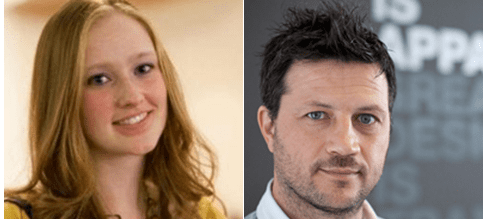The best of BrightonSEO Conference 2013 in a Nutshell
The other week, the team and I ventured to Brighton for the annual SEO conference organised by the lovely folks at Site Visibility. Here, I’ve compiled my thoughts on the best speakers of the bunch and suggested how their insights might be implemented by brand owners.
[Editor's note. Readers interested in this article may also like to check out this post from Rhian Simm's on 5 key SEO takeaways from BrightonSEO].
This roundup is from the speakers who really stood out, dropping invaluable tips and drawing on fascinating case studies to illustrate how to get the most out of SEO which I thought would be most useful to share.
Speaker Oliver Snoddy on Real-Time Marketing for any Brand

Speaker: Oliver Snoddy - Head of Planning, Twitter UK
Mr Snoddy kicked off the day in fine form, setting the tone for the rest of the conference by announcing that 'Good content always rises to the top, wherever it comes from.' Whether or not this is strictly true (plenty of great content sinks without a trace, sadly, believe me, we know being the iGaming space) this sentiment coloured the whole day.
Most speakers stressed that quality content is paramount in modern SEO and marketing as a whole.
Snoddy also talked about the conveyance of information through visible social interaction. This chain of dynamic exchange drives Twitter, resulting in the cascades of shared information for which the platform is known.
To that end, website operators have to innovate around people’s everyday web usage. Snoddy outlined a triumvirate of Twitter ‘moments’ that should factor into real-time scenario planning: everyday moments ('Made cookie monster cakes: nailed it'), live moments (#ArcticMonkeysGlasto2013) and connected moments (“go f*ck yourself” @Nigel_Farage).
Brands need come up with clever marketing strategies involving these moments, then allow the natural motion of social exchange to propagate their content. Simples.
Stuff to Take Away from this Speaker
- Good content should travel, irrespective of its source (living an ideal world are we Oliver?)
- Content sharing on Twitter is driven by the activities of a visible crowd.
- Successful real-time marketing should take advantage of different Twitter ‘moments.’
Speaker Jennifer Sable Lopez on The Ins and Outs of Testing Social

Speaker: Jennifer Sable Lopez – Head of Community, Moz
Moz’s Social Media Representative carried off a superb presentation, radiating energy and enthusiasm while imparting loads of great tips for optimising social media strategies.
Needless to say, the hashtag ‘J-Lo@BrightonSEO’ was trending all morning. What an awesome name.
Advancing Snoddy’s line, Lopez declared boldly 'Content is King and SEO is dead.' As you can imagine, the shocked silence in the Brighton dome was deafening, punctuated by occasional whimpers of former Black-Hat SEO specialists blubbing into their coffee cups. Again, this isn't necessarily true but the idea of SEO being a one-processed practice is certainly no longer the case.
Lopez focused on improving the effectiveness of social media outreach, which (she argues) depends on identifying content that drives reach and that which drives engagement. Engagement is the real goal, but successful social outreach should foster interaction between these content types.
This post really dives deep into the ways in which we can achieve Lopez's advise, explaining how we can use Facebook to understand our audiences. This of course leads to a far more pragmatic approach when attracting the right fans, advocates or in many cases... tweeps.
According to Lopez, the key to getting the best out of social media outreach lies in testing and improving outreach strategies.
To that end, she recommended a number of excellent services for obtaining site analytics, including FollowerWonk, Simply Measured and True Social Metrics. Best check ‘em out, eh?
Stuff to Take Away from this Speaker
- Content is King, SEO is dead (if you say so J-Lo).
- Successful social outreach must identify the content that promotes reach and that which drives engagement.
- Adding my own one here: Successful social outreach begins with understanding your audience.
- Relentlessly test and improve social outreach strategies.
Speaker Phil Nottingham on Video Hacks

Speaker: Phil Nottingham – Head of Memes and Trolling, Distilled
It speaks volumes about the state of contemporary SEO that someone can obtain a job title like ‘Head of Memes and Trolling’ and be invited to a major conference as a guest speaker.
Still, the emphasis of Phil's presentation was less on cats and epic fails than developing low-budget, high-quality video campaigns. On those terms, it was a resounding success.
As it turns out, online brands don’t have to a. spend a fortune on optimising video content or B. have Martin Scorsese on staff to produce decent vids. Both of which would lead small businesses to financial ruins before they've started. Lots of work can and should be done in-house, but Nottingham concedes that companies may wish to outsource editing. Cutting and pasting aside, it’s amazing what can be achieved with a cheap condenser mike, some tarp and a key-light.
Quick Tip: We used Fiverr.com (a freelance community where you can pay just $5 for nearly anything) and had an introduction built for our videos. In total, we paid for three different versions totalling $15 which resulted in a professional feel across all video content: see this example on a roulette strategy.
Using Wistia (a search engine friendly video platform) we were also able to achieve in-snippet-videos within our rankings which gave us a small but noticeable boost too: see this search ranking example on the law of the third stream strategy.
As we all know, videos on YouTube do not drive too much traffic to websites. That’s not to suggest that traffic is the be all and end all. In brief, uploading videos via different platforms achieves different ends.
- For conversions, brands should self-host videos.
- For brand awareness, videos should be uploaded to YouTube and other platforms alike.
- For links and social outreach, brands should self-host videos and then upload them to YouTube. The list goes on...
Stuff to Take Away from this Speaker
- Video production/campaigns can be affordable, while remaining effective.
- Adding my own one here: Use websites like Fiverr.com to get cheap, professional looking videos.
- Website operators should be mindful of their goals when developing video content.
Business strategies should drive video production, not the other way around .. the most important lesson here
Speakers Bridget Randolph and Justin Taylor on Mobile Strategy for Small Businesses AND Design for Mobile, Responsive or Adaptive

Speakers: Bridget Randolph – Marketing and Advertising, Distilled and Justin Taylor – Author, Graphitas
I’ll go over these presentations together as they covered a lot of the same ground. Bridget Randolph did an excellent job of highlighting the scale of mobile as a web platform with some choice figures.
Apparently there were more mobile web users in 2012 than there were web users of any kind in 2000 and four out of five people who use Facebook daily access the service on a mobile device. Without meaning to sound so cliche; the numbers speak for themselves.
It’s hardly surprising that social media and mobile web go hand in hand, but what about brands developing their own mobile websites? According to Randolph, mobile websites are a ‘starting point’ rather than a strategy in and of themselves.
Justin Taylor developed this starting point, offering some tips for optimising web design for mobile platforms.
- Firstly, design from the users’ perspective and cut down on the clutter - something we've been very active with at my company in recent months.As an affiliate company we want to provide the user with as much information on a given brand or game as possible. It's about tackling that on a regular basis and making sure we're providing the right information in the most digestible format; that's really where cutting the clutter and mobile come in.
- Secondly, consider the circumstances of the user and enhance their experience with mobile features (voice, location, touch).
- Finally, remember to sell to your customers’ customers.
Stuff to Take Away from this Speaker
- Mobile is huge and (barring a few hiccups) is only getting bigger.
- ‘Developing mobile websites’ is not a strategy in and of itself, but it's a great start.
- Be mindful of how to optimise the mobile experience for users. It’s a mistake to think of a mobile platform as a portable desktop.
- Adding my own here: think about the users intent when on a mobile. For many users, the same query could have a totally different intent to that of a desktop search.
Speaker Stacey Cavanagh 0n Low Cost Link Building with Juicy, Juicy Data

Speaker: Stacey Cavanagh - Head of Search, Tecmark
What kind of content has the potential to go viral and drive traffic to websites? Well ain’t that just the million dollar search engine query?
Never fear, Stacey Cavanagh reckons she’s got the answer! According to her, viral content campaigns have to be newsworthy, entertaining, humorous and relevant to a large audience. See? Easy!
Cavanagh structured her presentation around a case study: a survey/viral content campaign that aimed to create brand exposure for Techmark and drive traffic to their website.
Cavanagh asked 1,000 Americans to name a city in England outside of London, documenting the top 10 answers. Naturally, the results were staggeringly thick, with Wales and even Paris making the cut.
Playing on the popular stereotype (I personally do not agree with this ridiculous stereotype) that Americans are intellectually challenged, the list was an enormous success, generating tens of thousands of hits, coverage on Buzzfeed and many other websites as well as driving 10,000 visitors to Techmark. All of this was achieved with $25 spent on the survey, two hours writing up the post and a bit of social sharing to get the ball rolling. Just goes to show…
Stuff to Take Away From This Speaker
- Make use of the Freedom of Information Act: you’ll be surprised what you can obtain for next to nothing.
- Present and format data in an innovative way, infographics are great, but dig a little deeper.
- Contact Journalists through Journalisted.com to disseminate your post.
- Contribute to public debate through your survey content.
Content is King! Kind of…
So, in sum, what did I take away from my visit to Brighton? Well, it seems the writing is on the wall for conventional SEO. The core of this conference was all about content: how to produce it, how to optimise it and how to make it sing.
However, in my experience, it’s still all too easy for great content to die on its arse. The best post in the world is worthless if no bugger ever sees it. The way I see it, it’s still not enough to assume that the best content will out.
You must strategically plan and produce while putting in place optimum outreach schedules, which often be an amalgamation of multiple channels. Though, the right channel is only so if you target the right users. Hopefully that's something for you to think about.
A few final thoughts on SEO
- Understand your audience. Without this, the rest is very difficult!
- Good content is essential, but it needs to be seen and this won’t happen by itself.
- Look to the future for potentially lucrative platforms (mobile is a biggie).
- Invest in paid outreach, there's nothing wrong with a display/search/social boosting campaign to help push new content out there.
- Keep track of user activity and develop cogent strategies for driving website traffic based on this data.
Anything else to add? If so, I'd like to talk about it in the comments...

Thanks to
Michael Charalambous for sharing his advice and opinions in this post. Michael has been in the digital space for over 7 years, loves business and traveling and is a Director at gaming company
Right Casino Media. You can join him in conversation on
Twitter,
LinkedIn,
Facebook or
Google+.








 Thanks to
Thanks to 


